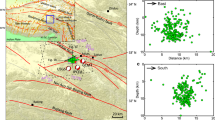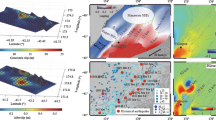Abstract
At first time, we observed the postseismic deformation, which actually is a kind of creep after slip, along the intra-plate active fault associated with the Wenchuan earthquake. To understand the near-field postseismic deformation following 2008 Wenchuan earthquake in Sichuan Province of China, we compared the fault scarp or flexure scarp profiles measured in different campaigns. Our result shows that among total 19 observation sites, on 13 sites (68% of 19) fault scarps fall back with an average about 9.7% decrease; on 5 sites (26% of 19) fault scarps present no change; and on one site (6% of 19) fault scarp continues to uplift with 12.8% increase. The variety of fault scarp we observed results mainly from near-field postseismic deformation, after slip occurred in shallow. Based on our observations, the following are demonstrated: except for the southwestern end near Yingxiu Town where coseismic slip deficit and some elastic energy residue exist there, fall back (68%) or non-changing (26%) of fault scarp shows energy balance or energy deficit due to overthrust, implying that the likelihood of occurrence of strong aftershocks of ⩾ M7 becomes very small in these energy-released areas. Moreover, we suggest that a minimum of 10% error due to near-field postseismic deformation should be considered when evaluating the magnitude of historic and paleoearthquake or slip rate based on the fault scarp displacement, even though the error caused by erosion has been accounted already.
Similar content being viewed by others
References
Tse S T, Rice J R. Crustal earthquake instability in relation to the depth variation of frictional slip properties. J Geophys Res, 1986, 91: 9452–9472
Scholz C H. The Mechanics of Earthquake and Faulting (Second edition). Cambridge: Cambridge University Press, 2002
Shen Z K, Jackson D D, Feng Y, et al. Postseismic deformation following the Landers earthquake, California. 28 June 1992. Bull Seismol Soc Am, 1994, 84: 780–791
Savage J C, Svarc J L. Postseismic relaxation following the 1992 M7.3 Landers and 1999 M7.1 Hector Mine earthquakes, southern California. J Geophys Res, 2009, 114: B01401, doi:10.1029/2008JB 005938
Perfettini H, Avouac J P. Postseismic relaxation driven by brittle creep: A possible mechanism to reconcile geodetic measurements and the decay rate of aftershocks, application to the Chi-Chi earthquake, Taiwan. J Geophys Res, 2004, 109: B02304, doi:10.1029/2003JB002 488
Barbot S, Hamiel Y, Fialko Y. Space geodetic investigation of the coseismic and postseismic deformation due to the 2003 Mw7.2 Altai earthquake: Implications for the local lithospheric rheology. J Geophys Res, 2008, 113: B03403, doi:10.1029/2007JB005063
Gahalaut V K. GPS measurements of postseismic deformation in the Andaman-Nicobar region following the giant 2004 Sumatra-Andaman earthquake. J Geophys Res, 2008, 113: B08401, doi: 10.1029/2007JB005511
Kayanne H, Ikeda Y, Echigo T, et al. Coseismic and postseismic creep in the Andaman Islands associated with the 2004 Sumatra-Andaman earthquake. Geophys Res Lett, 2007, 34: L01310, doi: 10.1029/2006 GL028200
Kreemer C, Blewitt G, Maerten F. Co- and postseismic deformation of the 28 March 2005 Nias Mw8.7 earthquake from continuous GPS data. Geophys Res Lett, 2006, 33: L07307, doi:10.1029/2005GL025566
Perfettini H, Avouac J P. Modeling afterslip and aftershocks following the 1992 Landers earthquake. J Geophys Res, 2007, 112: B07409, doi:10.1029/2006JB004399
Peltzer G, Rosen P, Rogez F, et al. Poroelastic rebound along the Landers 1992 earthquake surface rupture. J Geophys Res, 1998, 103: 30131–30145, doi:10.1029/98JB02302
Pollitz F F, Wicks C, Thatcher W. Mantle flow beneath a continental strike-slip fault: Postseismic deformation after the 1999 Hector Mine earthquake. Science, 2001, 293: 1814–1818, doi:10.1126/science.1061361
Pollitz F F. Transient rheology of the uppermost mantle beneath the Mojave Desert, California. Earth Planet Sci Lett, 2003, 215: 89–104, doi:10.1016/S0012-821X(03)00432-1
Owen S, Anderson G, Agnew D C, et al. Early postseismic deformation from the 16 October 1999 M w 7.1 Hector Mine, California, earthquake as measured by survey-mode GPS. Bull Seismol Soc Am, 2002, 92: 1423–1432, doi:10.1785/0120000930
Jacobs A, Sandwell D, Fialko Y, et al. The 1999 (M w 7.1) Hector Mine, California, earthquake: Near-field postseismic deformation from ERS interferometry. Bull Seismol Soc Am, 2002, 92: 1433–1442, doi: 10.1785/0120000908
Freed A M, Bürgmann R, Herring T. Far-reaching transient motions afterMojave earthquakes require broad mantle flowbeneath a strong crust. Geophys Res Lett, 2007, 34: L19302, doi:10.1029/2007GL03 0959
Chen Y T. On the Magnitude and the fault length of the great Wenchuan earthquake. Sci Techn Rev, 2008, 26: 26–27
Xu X W, Wen X Z, Ye J Q, et al. The Ms8.0 Wenchuan earthquake surface ruptures and its seismogenic structure. Geol Seismol, 2008, 30: 597–629
Li C Y, Wei Z Y. Deformation styles of the northernmost surface rupture zone of the Ms 8.0 Wenchuan earthquake. Geol Seismol, 2008, 31: 1–8
Ran Y K, Shi X, Wang H, et al. The maximum coseismic vertical surface displacement and surface deformation pattern accompanying the M s 8.0 Wenchuan earthquake. Chinese Sci Bull, 2010, 55: 841–850
Deng Q D, Ran Y K, Yang X P, et al. Active Tectonics Map of China (1: 4000000) (in Chinese). Beijing: Seismological Press, 2007
Ran Y K, Chen L C, Chen G H, et al. Primary analyses of in-situ recurrence of large earthquake along seismotectonic fault of the Ms 8.0 Wenchuan earthquake. Geol Seismol, 2008, 30: 630–643
Reid H F. The mechanism of earthquake. In: The California Earthquake of April 18, 1906, Report of the State Earthquake Investigation Commission, Vol. 2, Washington DC: Carnegie Institute, 1910, 1–192
Thatcher W. The earthquake deformation cycle, recurrence, and the time-predictable model. J Geophys Res, 1984, 89: 5674–5680
He C R. Numerical simulation of earthquake nucleation and precursory process in slipping fault planes. Earthquake Res Chin, 2000, 16: 1–13
Dieterich J H. Modelling of rock friction: 1. Experimental results and constitutive equations. J Geophys Res, 1979, 84: 2161–2168
Dieterich J H, Kilgore B. Direct observation of frictional contacts: New insights for state-dependent properties. Pure Appl Geophys, 1994, 143: 283–302
He C, Wong T F, Beeler N M. Scaling of stress drop with recurrence interval and loading velocity for laboratory-derived fault strength relations. J Geophys Res, 2003, 108(B1): 2037, doi: 10.1029/2002JB 001890
Rice J R. Heating and weakening of faults during earthquake slip. J Geophys Res, 2006, 111: B05311, doi:10.1029/2005JB004006
He H L, Sun Z M, Wei Z Y, et al. Rupture of the Ms 8.0 Wenchuan earthquake along Baishahe River. Geol Seismol, 2008, 30: 658–672
Wang P, Fu B H, Zhang B, et al. Relationships between surface ruptures and lithologic characteristics of the Wenchuan M s 8.0 earthquake. Chinese J Geophys, 2009, 52: 131–139
Author information
Authors and Affiliations
Corresponding author
About this article
Cite this article
He, H., Wei, Z., Shi, F. et al. Near-field postseismic deformation along the rupture of 2008 Wenchuan earthquake and its implications. Chin. Sci. Bull. 55, 2535–2541 (2010). https://doi.org/10.1007/s11434-010-3259-4
Received:
Accepted:
Published:
Issue Date:
DOI: https://doi.org/10.1007/s11434-010-3259-4




